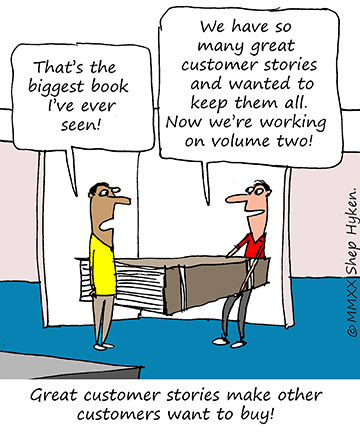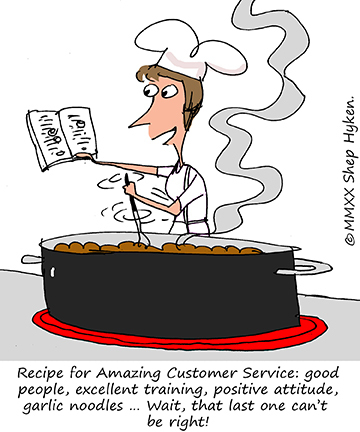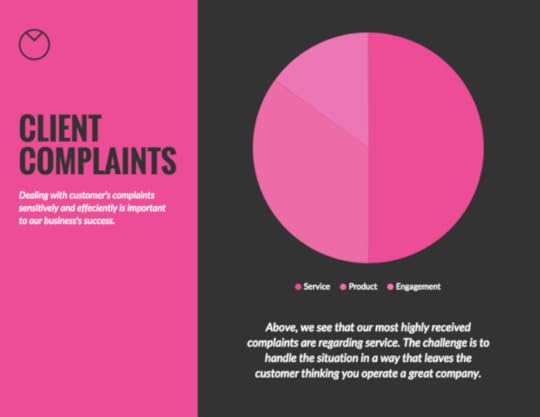Shep Hyken's Blog, page 94
December 7, 2020
5 Top Customer Service Articles For the Week of November 7, 2020
Each week I read a number of customer service and customer experience articles from various resources. Here are my top five picks from last week. I have added my comment about each article and would like to hear what you think too.
Five Customer-Service Lessons From the Late Tony Hsieh by Ann-Marie Alcántara
(Wall Street Journal) The former chief executive of Zappos, the online shoe retailer, had a unique approach toward customers.
My Comment: Tony Hseih was an iconic businessman who impacted the world of business. His life was cut short when he died in a fire last week. Our sincere condolences to his family and friends. Here are some lessons and reminders from the late and great business rock star.
The NOW of Work by Mitel
(Mitel) In this guide, we’ll explore the challenges and opportunities in the now of work, with advice from analysts and practitioners in the field.
My Comment: Our friends at Mitel have created a very cool ebook with a fantastic user experience. Titled “The NOW of Work,” the ebook focuses on what’s new in technology, employee communication and motivation, and more. Numerous experts were consulted. When you click on their images, their insights appear. Very cool!
Six Steps for Improving Customer Engagement and Loyalty by Genelle Kunst
(Chain Store Age) Establishing a loyalty program is a fundamental first step to improving customer loyalty. However, there are other key strategies that can help improve customer engagement and retention.
My Comment: Want to build repeat business and customer loyalty? This article should spark some ideas. Giving the customer a self-service experience, which goes beyond customer service/support, but is baked into the entire buying process, is a good place to start. These ideas focus on retail, but as I keep preaching, apply to just about any business and industry.
Top Retail Trends and Innovations That Drive Better CX by The CX Insights
(The CX Insights) Seven emerging trends in retailing will frame reactions for both the shorter and longer-term, induce resilience, and prepare consumers to thrive in the days after coronavirus.
My Comment: Even if you’re not in the retail industry, you’ll pick up a few ideas from this list of seven trends and innovations in this article. The first trend is about health and safety. That’s paramount for any business in any industry. Read the article and brainstorm how one or two (or all) of these apply to your business.
Building The Backbone of Your Business: Customer Service and Support by Andrew Madeira-Silva
(Bookmark) With the massive spike in online sales due to the pandemic this year, you can expect more site traffic than ever. So if you want your customers to leave your site with a smile, this is what you’re going to need to know.
My Comment: The backbone of almost any business is its customer service and support. Here’s a list that includes reminders and a few new ideas. For example, in the retail world returns should be as easy as the purchase. For all of us, a frequently asked question page (or two or three) will save the customer time, making for a better customer experience. And there are nine more!
 Shep Hyken is a customer service expert, professional speaker and New York Times bestselling business author. For information on The Customer Focus
Shep Hyken is a customer service expert, professional speaker and New York Times bestselling business author. For information on The Customer Focus customer service training programs go to www.TheCustomerFocus.com. Follow on Twitter: @Hyken
customer service training programs go to www.TheCustomerFocus.com. Follow on Twitter: @Hyken
The post 5 Top Customer Service Articles For the Week of November 7, 2020 appeared first on Shep Hyken.
December 4, 2020
Guest Post: How to Build Your Customer Experience Roadmap
This week we feature an article from Liliana Petrova, founder of The Petrova Experience. She writes about preparing a productive and successful customer experience strategy and why it’s important to have one.
This summer, The Petrova Experience conducted a Customer Experience Preparedness Survey. One of our questions assessed brand maturity in terms of customer experience strategy. Only 28% of the respondents had a well-defined customer experience strategy.
What Happens When You Don’t Have a Clear Strategy?
That means two-thirds of the organizations we surveyed have not prioritized customer experience in their budgets and overall strategy. We are here to tell you that there is no better time than now to start this process.
We are living in a transformational period. No matter your industry, you need to pivot to one extent or another in order to meet your customers where they are. Without a well-defined customer experience strategy and roadmap, you risk investing in the wrong technology and designing the wrong experiences.
Wrong Technology
When we refer to investing in the wrong technology, we are talking about technology solutions that are too expensive, have low adoption, and fail to deliver ROI.
Let’s take an airline that invests in a paid facial recognition fast track experience at the security checkpoint. If this airline has primarily leisure travelers (i.e. families, vacationers, infrequent travelers) the adoption of this technology will likely be low. This is an example of the “next shiny thing” investment that is not strategic and will have a limited impact on the customer experience of that airline.
Wrong Customer Experience
Similarly, when we talk about the danger of creating the wrong overall experience, we are talking about experiences that are not connected. These experiences feel like a patch on the customer journey, rather than elements of a unified whole.
These are the kinds of experiences that affect ONLY one moment on the customer journey, in isolation. As we have seen, if you do just one thing for experience, in a vacuum, absent of strategy, you are likely to generate more dissatisfied customers than if you had done nothing. Consider this seriously.
When you offer only one better touchpoint, all the other points look and feel even worse. So, take the time to build your customer experience roadmap and align your budgets with it. Do it yourself, or engage with a customer experience consultant like us. But make sure you do something to position yourself for the 2020 customer. They deserve it.
What is a Customer Experience Roadmap?
A customer experience roadmap is a long-term timeline (covering 5 years) that includes both large and small customer experience projects. Together, these projects build the customer experience you envision for your customer. Further, the roadmap enables your organization to get behind the funding required to get things done.
See, it is one thing for your CFO to say in a meeting, “Yeah, I agree we should invest in our customer experience in the next few years.” But it is much more powerful to get that same person to say, “I approve the 5-year investment of $20M in our customer experience roadmap that includes our digital experience transformation, contact center refresh, and hospitality training of all our frontline employees.”
Do you see what I just did?
I created a high-level customer experience roadmap for you. And I got your CFO to make a budget commitment! All you need to do is allocate those $20M appropriately and begin your work. Think of the customer experience roadmap as one of your most powerful tools to transition vision and strategy to significant operational efficiencies and experience improvements.
Customer Experience Roadmap Case Study
Let’s put this in practice. Imagine you are a major airport and a hub with wide and narrow body planes coming and both domestic and international passengers.
Take it a step further, and imagine you are bombarded by all kinds of technology firms telling you they can help you build a contactless experience for your customers. Where do you begin?
You know you have to do something, but you have no idea where to begin. This is where your customer experience roadmap comes to the rescue! Once you have defined what your passenger experience should be, and that contactless is part of your vision, you are ready for your roadmap.
We know restroom cleanliness is a major passenger complaint. So, that could be your first item. Biometric technology is another important item to add to this airport’s customer experience roadmap. But not just biometrics! Think through WHAT you need to use the technology for in relation to your staff and your passengers. Last but not least, allocate funding for your customer experience communications. Often, this is overlooked and/or underfunded. Especially for our imaginary airport, passenger communications should take up a good part of the roadmap.
Creating a customer experience roadmap is not an easy exercise. It takes time. It will take even more time to socialize it to the proper people who need to support its execution. A successful customer experience roadmap is driven by customer insights and your customer experience strategy. And it is well worth the effort – for you, your brand, and your customers.
Liliana Petrova CCXP pioneered a new customer-centric culture that energized more than 15,000 JetBlue employees. Future Travel Experience & Popular Science awarded her for her JFK Lobby redesign and facial recognition program. Committed to creating seamless experiences for customers and greater value for brands, she founded The Petrova Experience.
F
 or more articles from Shep Hyken and his guest contributors go to customerserviceblog.com.
or more articles from Shep Hyken and his guest contributors go to customerserviceblog.com.
Read Shep’s latest Forbes article: Ten Business Predictions for 2021 Part Two
The post Guest Post: How to Build Your Customer Experience Roadmap appeared first on Shep Hyken.
December 2, 2020
The Story Tells the Story
 What’s your story? What reasons compel your customers to do business with you? What gets them excited about doing business with you?
What’s your story? What reasons compel your customers to do business with you? What gets them excited about doing business with you?
Consider this. If you’re selling a trip to Hawaii, you probably try to paint a vision of a day on the beach, an amazing luau and a beautiful oceanfront balcony that includes a gorgeous sunset. The story you don’t tell—at least I hope you don’t—is the one that includes the technical specs of the engine on the plane that’s flying you to that exotic location, the type of tires on the resort’s van that will be waiting at the airport or the number of parking spaces in the resort’s parking lot. No, you don’t share technical specs when you’re trying to sell a vacation.
When you’re trying to get your customers to buy into the experience you’re creating for them, it’s the story that will do it. Create the image in your customer’s mind. If you really want to get them excited, get your customers to help paint that picture in the form of online reviews or testimonials on your website.
For example, I was getting ready to buy something on Amazon recently. I thought I knew what I wanted until I started reading the reviews for similar products from different manufacturers. For the most part, the product descriptions were the same; all had very positive reviews about the quality of the product and the fast shipping. That gave me confidence; however, it was the reviews that included a story that ultimately made me choose one product over another. It’s important to note that while you may have provided a story in the description, the reviews (or testimonials) were in the customers’ words, not yours. Customers love to hear from other customers.
How do you get these types of reviews or testimonials? Ask for them—but ask the right way. Most people would ask, “If you are happy with (whatever the product or service is), would you mind leaving a review?” That’s going to get you a nice rating as long as you deserve it. But if you want the customer to tell the story, try asking a different way: “Can you please leave a review and tell everyone how you’re using the product?”
Do you see the difference? One is asking for a rating. The other asks for a story. This may sound like common sense, but look at reviews for different products and you’ll see a big difference between ratings and stories. The point is that stories make you want to buy. Customers love the story.
Shep Hyken is a customer service expert, keynote speaker, and New York Times bestselling business author. For information, contact 314-692-2200 or www.hyken.com. For information on The Customer Focus customer service training programs, go to www.thecustomerfocus.com. Follow on Twitter: @Hyken
customer service training programs, go to www.thecustomerfocus.com. Follow on Twitter: @Hyken
(Copyright © MMXX, Shep Hyken)
The post The Story Tells the Story appeared first on Shep Hyken.
December 1, 2020
Amazing Business Radio: Philippe Mesritz

How Chatbots Can Deliver Better Customer Service
Leveraging Technology to Amaze Your Customers
Shep Hyken interviews Philippe Mesritz, Khoros’ first VP, Customers for Life. They discuss how chatbots and other technology can help deliver a better customer experience.








Top Takeaways:
Now more than ever, it’s incredibly important to pay attention to your digital customer experience. Most organizations have made the move to virtual, and all should understand how their customers are connecting with them.
The COVID-19 pandemic has accelerated what was already starting to happen in terms of technology. We have been thrust 3-5 years into the future.
Technology allows brands to reach customers where they are rather than forcing customers to come to brands. It also helps brands communicate more effectively with their customers for a faster, better experience overall.
Both customers and chatbots must be able to decide when to switch from AI to a human being. And, it should be an easy and seamless transfer. Otherwise, customers may end up frustrated with the experience.
People use AI all the time without realizing it. It’s important to remember that even big, well-known bots (such as Amazon Alexa and Google Home) that are powered by massive AI can still make mistakes.
Bots can be just as—if not more—effective in supporting agents behind the scenes as assisting customers on the front line.
Train your agents how to interact with and interpret your chatbot. Working together, agents and chatbots can provide a much better experience to the customer.
Your chatbot should work side-by-side with your CRM to help agents better understand your customers. A single pane of glass, with all the customer’s information, is ideal!
Chatbots will not replace agents. Instead, the roles of those agents will change and evolve alongside chatbots.
Both humans and chatbots have their strengths. Chatbots are good at automation, speed and efficiency, whereas humans excel at critical thinking and relationship development. You can’t automate a relationship!
Quotes:
“Think about your customers’ digital experience as the first solution, the first frontier and the thing your company wants to solve for.”
“AI isn’t fully intelligent yet. We’re a long way out from perfect, so you have to be able to allow customers to break out of the system and talk to a human. Otherwise, it’s frustrating and it’s not a great experience.”
“What humans are really good at is that critical thinking component, versus the bot which is more automation, more capabilities and more speed.”
“When it comes to relationships and building that loyalty, that’s where humans like to have other humans around them.”
About:
Philippe Mesritz is the first VP, Customers for Life at Khoros, a tech company that helps companies better connect with their customers online. He has over 20 years of customer-facing experience and previously ran the support services organization.
Shep Hyken is a customer service and experience expert, New York Times bestselling author, award-winning keynote speaker, and your host of Amazing Business Radio.
The post Amazing Business Radio: Philippe Mesritz appeared first on Shep Hyken.
November 30, 2020
5 Top Customer Service Articles For the Week of November 30, 2020
Each week I read a number of customer service and customer experience articles from various resources. Here are my top five picks from last week. I have added my comment about each article and would like to hear what you think too.
4 Tips for Getting Executive Buy-in on Your Customer Experience Strategy by Phil Britt
(CMSWire) With so much on the line for your customers, getting your leadership to buy in to CX strategies should be top of mind. To that end, we’ve put together these 4 tips to help get everyone on the same page.
My Comment: One of the common questions I’m asked is how to approach leadership to invest in customer service or CX. It could be training, an upgrade to software, etc. Well, here’s a short article that shows you how to take your ideas to the people who can make the decision.
CX Relationship Building: Balancing Empathy, Efficiency by Blair Pleasant
(No Jitter) Especially now, customers crave humanized experience and personal touch when it comes to service and support.
My Comment: I’m surprised to see empathy and efficiency discussed in the same article. Can they co-exist? According to this author they can.
A B2B company reworks its ‘clunky’ digital user experience by Peter Lucas
(Digital Commerce 360) Determined to transition from manual sales processes to eCommerce, construction equipment supplier Coates Hire discovered its eCommerce engine could do more—and also make its sales representatives more efficient.
My Comment: So many of the case studies about moving from traditional to online sales (eCommerce) are focused on B2C types of businesses – primarily in the retail industry. Here’s how a B2B construction equipment made the move. For any type of business that has been concerned with an online sales presence, this article is for you.
5 Customer Experience Trends That Won’t Change (And Will Likely Accelerate…) by Michael Hinshaw
(CustomerThink) Of the many initiatives planned and underway, we’ve identified five existing trends that won’t change – and in fact are accelerating, as both customers and the companies that serve them continue to assess and adapt to the new world around us all.
My Comment: This is the time of year when we see many predictions coming out. What intrigued me about this article is that the author didn’t predict anything new, but emphasized that some trends that have been going on for several years will continue and even accelerate in the new year. Okay, I guess that’s sort of a prediction!
The role of personalization in customer loyalty post-Covid by Nikki Gilliland
(Econsultancy) More people might be shopping online than ever before, but the concept of loyalty within retail has arguably been thrown up in the air.
My Comment: This topic intrigues me. Because of COVID-19, buying patterns have changed. What created customer loyalty in the past has changed a bit as well. It’s more important than ever to keep existing business. Don’t let the pandemic cause your customers to go elsewhere. This article focuses on personalization, which is one of the ways to prevent that problem from happening.
 Shep Hyken is a customer service expert, professional speaker and New York Times bestselling business author. For information on The Customer Focus
Shep Hyken is a customer service expert, professional speaker and New York Times bestselling business author. For information on The Customer Focus customer service training programs go to www.TheCustomerFocus.com. Follow on Twitter: @Hyken
customer service training programs go to www.TheCustomerFocus.com. Follow on Twitter: @Hyken
The post 5 Top Customer Service Articles For the Week of November 30, 2020 appeared first on Shep Hyken.
November 27, 2020
Guest Blog: How To Improve the Customer Experience Starting Today
This week we feature an article from Chelsea Lamb, co-founder and head tech writer at Business Pop. She provides multiple strategies to improve the customer experience in order to gain and retain repeat customers.
It’s been said that customer service is dead. Unfortunately, for many businesses, this is true. We live in such an instant gratification world that customers will often simply seek the next best thing if they don’t get the desired outcome to start. But, that does not mean that you cannot improve your customers’ experiences with your business. Doing so is the best way to retain the loyalty of those clients you’ve worked so hard to secure. Here are some tips.
Cut out the middleman where you can.
Depending on what you do, it makes sense to look at your processes and pipeline and find ways to reduce customer wait time. If you sell products, such as T-shirts, jewelry, or some electronics, you can do this by cutting out the middleman. Instead of ordering products, having them sent to you, and then, in turn, shipping them to your customers, look into dropshipping. This process, which involves your branded materials being packaged and shipped straight to your customers from the manufacturer/supplier, means you don’t have to keep inventory. It also means you are unlikely to run out of products that are in high demand. You’ll cut down customer wait times, and can offer a bigger variety of goods. There’s plenty of information online about drop shipping, and a quick Google search will tell you all you need to know.
Seek input from your employees.
Your employees are not only the backbone of your business, but they are also a voice that can tell you how you’re doing overall. Shep Hyken discusses this in the blog, “How to Avoid Roadblocks to Great Customer Service”. Don’t be afraid to ask your workers what you can do to eliminate bumps along the path from potential customers to happy, repeat clients.
Insert money where it matters the most.
When it comes to customer service, there are some areas that are going to be more impactful where your budget is concerned. Spend your funds wisely, and start investing in systems, products, and services that will ultimately lead to happier customers. This will look different for each business, and only you can make that determination. This might include things such as adding new staff members, buying new equipment, or upping your inventory levels if you are not dropshipping. You may need extra cash-in-hand, and you may need to seek small business funding to do so. Some programs, like the SBA Express Bridge Loan, a traditional SBA loan, or the Main Street Business Lending Program offer business owners the capital they need to achieve success.
Listen to your customers.
You’ve listened to your employees, and you’ve created better processes because of their feedback. But now it’s time to open your ears even further and listen to what your customers have to say. As Customer Thermometer explains, customer surveys are a great way to gain insight that you can turn into an action plan. A great customer survey will be targeted to the right people, be as distinct as possible, and be void of personal questions and biased opinions. Ask questions to your customers that revolve around product availability, shipping times, or customer service hours availability. Whatever you inquire about, listen carefully, and make changes that will benefit the majority of respondents.
At the end of the day, everything you do to improve your company will benefit your customers. But not all changes are created equally. If you want to have the biggest impact, start by listening to your customers and employees, and make sure that your investments are benefiting the people that fund your business.

Chelsea Lamb uses her tech background to provide insight and advice to those tackling the tech side of entrepreneurship. She is a co-founder and head tech writer at Business Pop .
F
 or more articles from Shep Hyken and his guest contributors go to customerserviceblog.com.
or more articles from Shep Hyken and his guest contributors go to customerserviceblog.com.
Read Shep’s latest Forbes article: Ten Business Predictions for 2021
The post Guest Blog: How To Improve the Customer Experience Starting Today appeared first on Shep Hyken.
November 25, 2020
Thanksgiving Week Special: A Recipe for Amazing Customer Service
 As we approach Thanksgiving, I can’t stop thinking about turkey and stuffing—and all the different ways to prepare them.
As we approach Thanksgiving, I can’t stop thinking about turkey and stuffing—and all the different ways to prepare them.
Always thinking about how everything in life ties to customer service, I wondered, “What is a good recipe for customer service?” So, I’ve listed some of the essential ingredients. I’m sure you’ll have a few more to add to this list. In the meantime, this is enough to get you started. As with any good recipe, feel free to spice it up a little!
The Right Culture: This is where it starts. Leadership defines the customer service and CX vision for everyone to follow.
Good People: The people on the inside of the organization create the experience for the customers on the outside.
Excellent Training: As good as the people are, without the right training, they are not able to fulfill their potential role in providing amazing customer service.
Good Leadership Role Models: Leadership may define the vision, but they must set the example as well.
Good Communication: I’ve always said that communication is the cornerstone of creating a Moment of Magic® (a positive customer experience). Without it, people say, “I don’t like doing business with them. They don’t understand me.”
Quick Response: How quickly to you respond to a phone call, email or text matters. A fast response is a powerful confidence builder.
A Sense of Urgency: This can be part of a quick response, but it’s more than that. It’s the idea, throughout the entire process, that you are urgently taking care of your customers. They know you are focused on them. By the way, this doesn’t mean rushing through the experience. It’s about showing urgency in the right places.
Taking Responsibility: If you have good people who have been properly trained, let them do their job. This is called empowerment. The best experiences happen when employees can make decisions and take care of customers without having to ask permission at every step along the way.
Attention to Detail: Sometimes it’s the “little things” that count. Pay attention to details and you’ll create a better service experience and build deeper confidence with your customers.
Positive Attitude: Having a positive attitude won’t make up for a blunder or complaint, but it goes a long way toward making a flawed experience better.
Collaboration: We shouldn’t ever feel like we’re alone on a deserted island. Having colleagues and managers around you can be of great assistance when you have a question or may not be 100% sure of what to do.
Empathy: This is the big word of 2020. You may care about your customer, but does the customer know it? What words do you use to respond to a customer’s comments and complaints? Do your customers feel that you know not only what they want, but also how they feel? That’s empathy.
Knowledge: It is expected that you will have the answers—or know where to go to get the answers—to the questions your customer has.
A Good Sense of Humor: This isn’t about making the customer laugh—although it’s not a bad thing if you do. It’s what can help us cope when we’re dealing with difficult customers. Sometimes you just have to smile—or even laugh—when you realize just how good you have it!
Happy Thanksgiving!
Shep Hyken is a customer service expert, keynote speaker, and New York Times bestselling business author. For information, contact 314-692-2200 or www.hyken.com. For information on The Customer Focus customer service training programs, go to www.thecustomerfocus.com. Follow on Twitter: @Hyken
customer service training programs, go to www.thecustomerfocus.com. Follow on Twitter: @Hyken
(Copyright © MMXX, Shep Hyken)
The post Thanksgiving Week Special: A Recipe for Amazing Customer Service appeared first on Shep Hyken.
November 24, 2020
Amazing Business Radio: Todd Hartley

Become Your Customer’s Trusted Advisor
Strategies for Building a Transparent, Successful Customer Experience
Shep Hyken interviews Todd Hartley, Founder and CEO of WireBuzz. They discuss strategies for leveraging video into your customer service experience.








Top Takeaways:
The goal of customer service should be to answer questions, eliminate confusion and become your customer’s trusted advisor.
Customer service training is your most valuable asset. It is always worth investing in.
More often than not, customers leave companies due to a lack of transparency or authenticity.
An amazing customer experience can translate directly into word-of-mouth marketing.
The customer experience doesn’t start after a customer makes a purchase or even on the first sales call. It begins at the first interaction the customer has with your company, which could be as simple as them browsing your website.
The sales experience is part of the larger customer experience. It’s what makes the customer say “yes” the first time, and hopefully keep saying “yes” over and over again.
Sales and service go hand-in-hand. If you’re in the sales process, your goal should be to demonstrate an above-and-beyond level of helpfulness and willingness to help your customers achieve their goals.
Video is a very powerful and effective tool and can be used for a variety of purposes. For example, send a video proposal instead of a PDF, or send a video recap to a decisionmaker after an important call. Video can also be used to cross-sell or upsell in the right scenarios.
Take the opportunity to learn what your client’s criteria for success are and position yourself in their future. Just ask: A year from now, what would have to happen for you to feel working with us was a success?
Ritualizing video into your CX can answer questions, share new information and position you to become your customer’s trusted advisor.
Quotes:
“Answer questions, eliminate confusion and become your customers’ trusted advisor.”
“People do business with people they have relationships with. We have to be in the business of developing relationships.”
“If you become a trusted advisor, you become a magnet for new opportunities, because the customer knows that you will take care of them at a very impressive level.”
About:
Todd Hartley is the Founder and CEO of WireBuzz and a rock star of remote selling, video marketing and sales optimization. He creates effortless, on-demand buying experiences that improve clarity and eliminate confusion.
Shep Hyken is a customer service and experience expert, New York Times bestselling author, award-winning keynote speaker, and your host of Amazing Business Radio.
The post Amazing Business Radio: Todd Hartley appeared first on Shep Hyken.
November 23, 2020
5 Top Customer Service Articles For the Week of November 23, 2020
Each week I read a number of customer service and customer experience articles from various resources. Here are my top five picks from last week. I have added my comment about each article and would like to hear what you think too.
4 Things Your Contact Center Can Learn Now From Chewy on How To Improve Your Customer Experience While Still Keeping Your Agents Happy and Productive by Veronica Krieg
(Sharpen Technologies) This month, we’re crushing on Chewy – an eCommerce leader paving the path to a better customer experience. We’re unpacking four strategies from Chewy’s service playbook and giving you actionable tips on how to use them to improve your own customer experience.
My Comment: I love learning from great companies. Chewy.com has an amazing reputation for great service, great products and compassion for their customers. Our friends at SharpenCX have given us an inside look at just how Chewy.com does it.
Southwest On The Importance Of Employee Experience by Tiffani Bova
(Forbes) There’s a message I frequently tell our customers: happy employees make customers happy. Southwest Airlines knows this – they excel by putting employees at the center of their business. As a recent report from Forbes Insights and Salesforce showed, that is the key to customer experience and revenue growth.
My Comment: As long as we’re learning from Chewy.com in our first article, how about we learn from Southwest Airlines. This time we don’t look at Southwest’s amazing customer experience. We look at their employee experience. Bestselling author, Tiffani Bova of Salesforce, has written a six-part series that discusses the connection between EX and CX. If you enjoy this article, you’ll want to download the full report.
Addressing L.L. Bean’s first customer service fiasco, 21st century-style by Paul Selby
(A Customer Service Perspective) Consider how L.L. Bean might address the same situation in the twenty-first century.
My Comment: Another great customer service icon is L.L. Bean. There is a story that happened toward the very beginning of their history that explains the type of company they are. 90 of the first 100 pairs of boots were defective and L.L. Bean stood behind every sale. While it almost ended the company from the very start, it created the foundation for their service and quality standards. The author takes this 100 year-old-story and looks at it through today’s modern lens.
How Useful Are Likelihood to Recommend Surveys? by Utpal Dholakia Ph.D.
(Psychology Today) Speed and simplicity are strong suits, but they fall short in other ways.
My Comment: I’m a huge fan of surveys and measurement when done the right way. One of my favorites is the NPS (Net Promoter Score). This article takes a psychological look at this ever-popular survey question and questions its validity. I’ll agree with some of the author’s ideas, but when NPS is used the right way, it is still one of the very best survey questions out there.
What are the benefits of implementing Service Recovery? by EHL Insights
(EHL Group) Implementing Service Recovery presents your company with many potential benefits.
My Comment: Why resolve customers’ issues and complaints? More than just the right thing to do, when we do it right, there are many benefits. More than just higher levels of customer satisfaction and losing potential customers (two of the seven benefits mentioned in the article), there is also the opportunity to debrief and troubleshoot the service failure, hopefully eliminating or mitigating it in the future.
BONUS
Three User Experience Trends Consumers Will Pay More For by Matt Wujciak
(CCW Digital) The effortless, instant gratification provided by Netflix, Tiktok, and the other industries mentioned above can be broken down into many components, telling us a lot about consumer behavior. But three in particular stand out.
My Comment: My friends at CCW Digital (Customer Contact Week) published a great article with three user experience trends that customers are willing to pay more for. The third one is about requiring few steps to make a purchase (as in convenience) and includes some of my commentary.
 Shep Hyken is a customer service expert, professional speaker and New York Times bestselling business author. For information on The Customer Focus
Shep Hyken is a customer service expert, professional speaker and New York Times bestselling business author. For information on The Customer Focus customer service training programs go to www.TheCustomerFocus.com. Follow on Twitter: @Hyken
customer service training programs go to www.TheCustomerFocus.com. Follow on Twitter: @Hyken
The post 5 Top Customer Service Articles For the Week of November 23, 2020 appeared first on Shep Hyken.
November 20, 2020
Guest Post: A Guide to Training Employees to Deliver Outstanding eCommerce Customer Service
This week we feature an article from Pawel Lawrowski, Head of Growth at Tidio. He shares six tips and strategies to share with your team for improving the eCommerce customer experience.
Poor customer service costs businesses over $75 billion a year in lost profits. It can turn into hundreds of negative reviews and bad word of mouth, which spreads quicker than a wildfire.
How to avoid that if you’re running an eCommerce business? Only by delivering amazing customer service.
Investing in the team’s skills is a great way to start. By coaching to handle every situation amazingly well, you can improve reputation and get more sales/
Here, you’ll learn five insightful tips to transform your eCommerce customer service by investing in your team.
1. Decide What “Amazing Customer Service” Means
Before you train your employees on how to provide amazing customer service, you need to clearly define what it means.
One way to do that is with a customer service vision statement. It includes:
Standards. These are micro-goals that drive your team towards customer satisfaction, e.g. “We will respond to email messages within 6 hours”
Strategies. These are strategies like “Hire empathetic people for customer support team” that maximize customer satisfaction.
Goals. These are critical goals, e.g. “Achieve XX percent customer satisfaction rate.”
The vision document is critical to set the direction for your team, so you need to make it clear. If some strategies need an explanation, illustrate them in a process infographic like the one.

Create an email newsletter and add the vision statement to share it with the team. Also, make it available at all times through your company’s document sharing service.
2. Create a Customer Service Process Flow
A customer service process flow is a visual representation of processes and procedures used to solve queries. It’s created for eCommerce brands to standardize service provision.
Your team needs it because it gives step-by-step instructions.
To create the flow:
Describe a typical interaction between a customer and an operator. Make it step-by-step to include every communication touchpoint.
Consider different scenarios. The flow must have different touchpoints based on the customer’s answers.
Include an explanation of each touchpoint in a separate document. It will help your team understand the purpose of each action.
3. Empower Employees to be Creative Problem Solvers
Allow employees to have some room for creative solutions without consulting the leader or manual on everything. Empowering instead of directing employees increases job satisfaction and quality of service.
But this requires your team to have appropriate knowledge and expertise. So, you need to have the best resources – guides, videos, tutorials – available.
Here are some great examples:
Shepard virtual training course. Teaches customer service teams to provide world-class service quality by focusing on customer amazement
How to find customer experience problems before they occur. A guide to discovering service problems that cause frustration before customers let you know about them.
Does your team need to develop a new skill? Consider having on-site training workshops by customer service experts. The workshops are customized to meet the unique needs of your employees.
Remember that employee education should be an ongoing process to keep service quality high and hit sales goals. Consider having an educational budget to address training needs.
4. Give Your Employees the Best Customer Service Apps
Live chat and chatbots are the best tools to reduce the response time and improve the customer satisfaction rate.
Live chat has the highest customer satisfaction rate because it allows real-time communication between the operator and the customer. All you have to do is add a live chat widget to your website.
Here’s how it could look like.

Next, a chatbot can help your team complete more queries by taking care of repetitive, common questions.
A chatbot on an eCommerce store can guide customers to popular pages like shipping policies, returns, and order status.

This way, you’re giving customers self-service options, which helps to take a lot of queries off the shoulders of your team.
Like live chat, you can add chatbots to all websites. For example, if you’re using a popular website platform like WordPress, install a WordPress chatbot. The same goes for Shopify and other eCommerce platforms.
5. Talk to Your Employees
A lack of regular feedback between employees and managers leads to a lack of motivation and subsequent deterioration of service quality.
Consider these meetings to keep the feedback flowing:
Weekly group meetings. During these, you can collect suggestions, tips, and learn about issues the employees experience while working
Bi-weekly one-on-ones. These meetings can help to collect feedback from individual employees.
Related: How to Improve Customer Experience Using Employee Feedback Data
6. Track and Measure Key Customer Service KPIs
Try using NPS (Net Promoter Score) and CSAT (Customer Satisfaction Score).
NPS is a customer satisfaction metric that can help you evaluate the quality of your service. To calculate it, you need to use website surveys. They have one question about how likely your customers are to recommend your service to others.
The customers respond using a 0 to 10 scale, with 0 being “Not likely” and 10 being “Very likely.”
Here’s how to interpret their answers:
0 – 6 – these customers are very likely to churn
7 – 8 – customers use your company, but they’re not ready to become loyal yet
9 – 10 – these are the loyal customers who are likely to buy again.
CSAT is an indicator of customer satisfaction. CSAT surveys can contain multiple questions (including the open-ended ones).
Important: customers aren’t always willing to explain the rating they’ve given and skip questions. If you need to collect more detailed feedback, consider using a free chatbot that you can customize to ask customers to share their experiences.
Related: 10 Surefire Ways to Improve CSAT Score.
Conclusion
Never stop investing in customer service.
It’s a critical part of eCommerce customer experience, which is something that many of your customers value more than price. Improving the skills of your customer service team is the best way to maintain a positive reputation, delight customers, and increase sales.
Pawel Lawrowski is Head of Growth at Tidio . He has 10+ years of experience in marketing and sales in the IT industry and enjoys sharing his knowledge with others. You can connect with him on Twitter or LinkedIn.
F
 or more articles from Shep Hyken and his guest contributors go to customerserviceblog.com.
or more articles from Shep Hyken and his guest contributors go to customerserviceblog.com.
Read Shep’s latest Forbes article: Do You Have The Guts To Refer To Your Competition? Burger King Does
The post Guest Post: A Guide to Training Employees to Deliver Outstanding eCommerce Customer Service appeared first on Shep Hyken.



